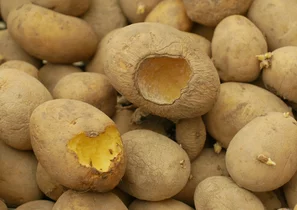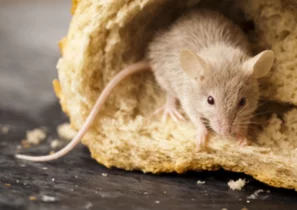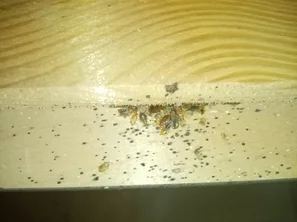Biocide Knowhow
Content
Voles and Mice: Outdoor and Indoor Pests with a Big Impact
Voles and Mice Cause Direct and Indirect Damage
Voles and mice can cause significant yield loss and damage to agricultural goods, stored food and even electrical wiring. In the field, their primary impact is on grasslands for fodder, of orchards where they damage fruit tree roots, and various vegetable crops. Beyond direct damage, their activities can alter pasture composition, leading to weed infestations and a decline in quality.
In addition to physical damage, their presence poses a hygienic risk, especially if they enter indoor areas, as they can transmit pathogens harmful to both humans and animals.

High Reproductive Potential Leads to High Damage Potential

Water vole population with unhindered reproduction (green line) with peak after 6-7 years. Population collapses due to epidemics and Lotka Volterra principle. Yellow line shows the population curve when controlled by natural predators or traps.
Both voles and mice have a very high reproductive potential. For example, field mice (Microtus arvalis) reach sexual maturity in just 13 days and start to reproduce. Without natural predators or control methods like traps, their populations can grow rapidly.
An observation of water voles (Arvicola terrestris) showed that their population can increase fivefold within just a few years (as shown in the diagram). Voles typically follow a six-year life cycle, during which their population grows and then collapses. This collapse is driven by epidemics and the Lotka-Volterra principle, which states that predator and prey populations fluctuate in a cyclical manner, with time lags, under constant conditions. As the number of prey increases, so does the predator population, which eventually reduces the prey population significantly. The diagram shows the population curves of a water vole population in a environment that supports unhindered reproduction (green line) compared to a situation where the population is controlled by natural predators or traps (yellow line).
The Importance to Control Voles and Mice before their Population Increases
Due to their high reproductive potential, it is crucial to implement control measures early in the season to prevent an extreme population increase of voles or mice. For outdoor areas, control should begin as soon as snow melts or when temperatures start to rise after winter. Our high-quality topcat mousetrap, made from stainless steel, provides a sustainable and highly effective solution. Additionally, our standby vole fence protects fields from re-immigration and damage by voles. Its participatory system, which includes wild animals checking and emptying trapped rodents in the standby boxes, makes it a highly efficient, low-maintenance investement. Indoors, mice tend to accumulate in the autumn as they seek overwintering sites. For indoor areas such as stables, storage rooms or private homes we developed the topsnap mousetrap. Known for its robustness, it is a long-lasting control tool that is easy to handle and safe for users, children, and pets. topsnap also allows for simple, non-digital monitoring, as catches can be easily checked visually from a distance using position indicators.
Advantages of Mechanical traps
The use of rodenticides for outdoor rodent control has been shown to harm wildlife that may ingest poisoned pests. Additionally, the use of chemical methods for gasifying rodents in their underground tunnels is prohibited in many countries due to the cruel nature of the death caused. Mechanical traps offer a toxic-free alternative to control rodent populations, both outdoors and indoors.


Effective Bed Bug Control: Solutions for a Peaceful Night's Sleep
Bed Bugs: A Persistent Human Parasite
Bed bugs have coexisted with humans for centuries, with their distribution and prevalence varying worldwide. These blood-feeding parasites prefer to feed at night, as they avoid light. In Europe, the most common bed bug species is Cimex lectularius. Bed bugs typically hide in dry cracks and crevices within homes, making them difficult to detect. They remain in these hiding place until attracted by increased carbon dioxide levels, such as those found in human breath. Remarkably, bed bugs can survive for up to a year without feeding under favorable conditions.

Bed Bug Life Cylce

Bed bugs lay their eggs, which resemble small white rice grains, in their hiding places. The freshly hatched bed bugs, called nymphs, are the juvenile form and, like adults, require a blood meal at each of their five nymph stages before reaching the adult form. As they mature, they shed their skin which can be an indication of a bed bug infestation.
The development from a newly hatched nymph to a sexually mature adult takes about one month at 27°C, though it takes longer at lower temperatures. A fertilized female bed bug can lay about 300 eggs during her lifetime, which lasts about 18 months. Nymphs hatch from freshly laid eggs after approximately twelve days.
Bed Bugs Give You Some Privacy
Bed bugs preferably feed on exposed human body parts, such as the hands or feet, and usually avoid going beneath the bedcovers. To date, there is no evidence of bed bug bites transmitting any diseases (Lai et al 2016). Initially, bed bug bites may go unnoticed, as their sting is not immediately felt. However, the bites can later cause itching or even swelling. They are often arranged in a line, as the bed bug tries multiple feeding sites. Aside from this pattern, the bites do not have a distinct appearance.

Linear sequence of bed bug bites
Bed Bug Detection

Daytime hiding place for bed bugs in the bedstead
Bed bug infestations can be difficult to identify, as the insects are adept at hiding and their bites do not have a characteristic appearance. Definitive evidence includes finding live bugs in their hiding spots or spotting them wandering at night in search of a blood meal. Additional signs, such as excrement stains or molting remains, indicate a current or past infestation.
An effective detection method involves trained bed bug detection dogs, which can identify infestations without requiring visible traces. Pheromone bait traps are another valuable tool for luring bed bugs. For the best results, traps should be placed near suspected hiding spots. Particularly effective are traps using aggregate pheromones, which attract both male and female bed bugs across all development stages.
Bed Bug Control
Aprehend®, curative and preventive control of bed bugs with a natural fungus
Beauveria bassiana is a naturally occurring fungus that can infect bed bugs. Its spores are present almost everywhere - in the air, soil, and on surfaces. The fungal spores act like a contact insecticide by sticking to the outer cuticle of the insect. Bed bug adults and nymphs are affected by walking on treated surfaces. Aprehend® is applied using a Low Volume Low Pressure spray applicator at low application rates. Once exposed, the fungal spores germinate, penetrate the insect's cuticle, and colonize its body, leading to death within 4 to 10 days.
With the specifically developed ready-to-use oil formulation of Aprehend®, the fungal spores remain viable and infectious for up to three months after application. This long residual efficacy ensures that even bed bug eggs, which hatch after the treatment, are affected. Aprehend® provides long-term control enabling to eradicate a bed bug infestation with a single application while also preventing re-infestation.
Control with diatomaceous earth
Diatomaceous earth is a powder derived from fossilised diatoms. Its tiny, sharp-edged particles damage the outer skin of insects upon contact, causing them to dehydrate and die. InsectoSec from Andermatt is a high-purity diatomaceous earth of tested quality, authorised for use as a biocide. For low infestations, it can be used as the sole control measure and is also effective as a preventative solution.
Heat treatment and fumigation as curative treatment
Professional electric heat ovens are an effective solution for treating entire rooms. By maintaining a temperature of 50- 60 °C for two days, this method eradicts bedbugs. Another option is fumigation with carbon dioxide, where the lack of oxygen effectively kills both bed bugs and their eggs. These methods are recommended for severe infestations. However, they are costly and provide no long-term or preventive protection against migrating bed bugs.
Chemical control
A variety of chemical agents are available for controlling bed bugs. However, the main disadvantage is that these substances can be harmful to humans and pets. In addition, bed bugs have developed resistance to some of these chemical agents, reducing their effectiveness. Chemical treatments should only be applied by professional pest controllers. Attempts by non-professionals often fail to achieve the desired results and may even cause bed bugs to spread to other rooms or neighboring units.

Bed bug infected with Beauveria bassiana after Aprehend® treatment